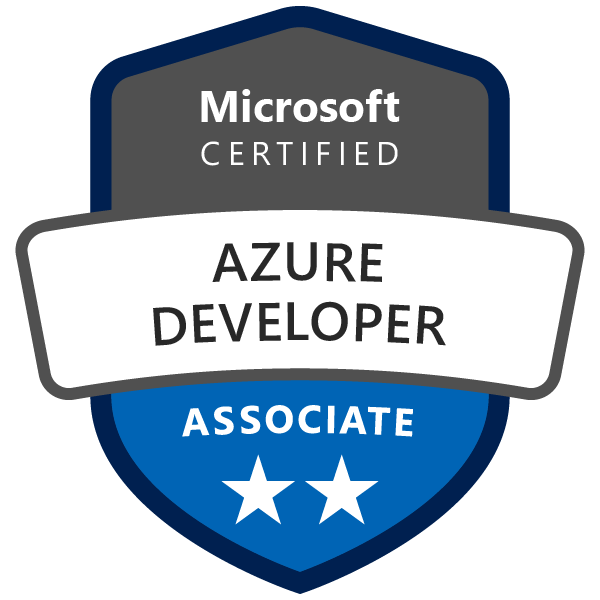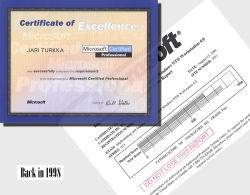Azure Developer Associate certification
Thursday, June 27. 2019
Yup.

Passed that one yesterday. For those intersted, it was a AZ-203: Developing Solutions for Microsoft Azure exam.
Previous one was 21 years ago:

Notice how they misspelled my name. Argh! ![]()
I bet many of you haven't used Windows NT4.0 Workstation for a while (or ever).
Also notice how the certification was issued by Mr. Bill Gates himself! ![]()
Trigger Azure CDN to update certificate to custom domain from Key Vault
Tuesday, June 18. 2019
I've said this multiple times: Everything in cloud computing is at least twenty times more complex than it used to be with your old-fashioned regular servers couple years ago. Things are complicated with physical servers too, but when you apply a cloud and don't have a server you could touch even if you wanted, the fog in your cloud just complicates every trivial thing. This is one of those overly-complex things I ran into and needed to get solved.
So here goes:
What happens when you combine short-lived HTTPS-certificates from Let's Encrypt with Azure Content Delivery Network?
Yeah. Misery.
Given the maximum time-span of three months for this free-of-charge certificate issued by Let's Encrypt ACME-system, a simple wish of making sure the most recent certificate is in use by Azure CDN proved to be much trickier than it needs to be. You would assume, that Azure-people understand the need to eventually have a new certificate running. The need is same for everybody, no matter where the cert came from. Yet again, assumption seems to be the mother of all f...ups.
Azure CDN users Azure Key Vault as a source of any custom certificate used by your custom domain at CDN endpoint. Uploading a X.509 certificate to Azure Key Vault is nearly trivial. You have the PKCS#12 file, upload it and boom! Done!
The next step proved to be nearly impossible. You need to inform CDN, that a new certificate is available and kindly suggest to start using it. CDN won't detect this change automatically, as I initially assumed.
After failing on my every attempt, as a last resort I posted the question in Stackoverflow, Update Azure CDN custom domain certificate from a script. As you might expect, the things I typically do with computers are on the more difficult side. The law of the ICT-jungle says: When questions are difficult, the answers are even more. This is something I knew at the time of posting the question, there are not too many people who would be able to solve my issue, or even fully comprehend the question.
Eventually I lucked out and Mr. Singh replied.
His suggestion seemed valid at a glance. The complexity hit me at the same glance. Instantly it became obvious, that testing the suggested action will not be easy. It took me a while to process all the required information/parameters/requirements, then wait for new certificate update cycle, craft a suitable approach to verify his suggestion. Eventually everything aligned just right. A new certificate was issued, I put some effort into investigating the suggested course of action and finally succeeded in my script-crafting and proved Mr. Singh suggestion to correct. The CDN Custom Domain API does work as he suggested. Go see it for yourself, the API docs are at https://docs.microsoft.com/en-us/rest/api/cdn/customdomains/enablecustomhttps.
My resulting PowerShell 6 script is at https://gist.github.com/HQJaTu/c5695626ba51c6194845fa60913e911b, go get it there.
For those trying to reason my choice of scripting tool, it's obvious: PowerShell Core runs on Azure Cloud Shell (go to https://shell.azure.com/ if you have an Azure account). Such scripts can be run on any browser capable of connecting to Azure. And yes, I do run Bash on everywhere, but I tend to NOT write scripts with it. Python or PowerShell have so much elegant approach on the important things, like error handling.

